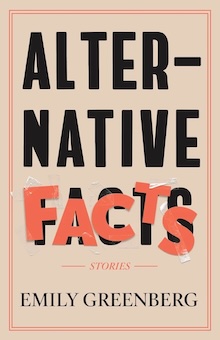
Kallisto Gaia, 2025
Short stories can help us see the world in new ways or they can reflect the world in which we find ourselves living. The stories in Alternative Facts, the extraordinary collection by Emily Greenberg, do both. In doing so, they take risks which pay off—at least for readers who appreciate adventurous fiction.
The stories are not necessarily realistic, though they are based on or built from facts in interesting ways. All of the stories intersect with real life, asking questions like: What is fact and what is fiction? What is real and what is not? When does fiction transform into nonfiction, and why does it matter? At the sentence level and conceptually, Greenberg’s writing echoes that of other, mostly postmodernist writers like Richard Powers, Jim Shepard, and David Foster Wallace. But Greenberg’s sensibility feels both fresh and contemporary. These questions about fact and fiction are important to consider at any time, but they are particularly urgent now, when facts are contested on a daily basis.
The title story, which also opens the collection, is a rambling interior monologue: Kellyanne Conway’s mind running at full speed during the first Trump inaugural ball. “Alternative Facts” consists of a single, very long, and complex sentence, at once utterly believable and utterly strange. As the clauses pile up, they are both enjoyable and troubling, full of frightening but still somehow humorous rationalizations. The narrator may not be any more likable at the end of the story than she was at its beginning, but she is understandable in a different way. It is a fitting start to the collection; the brilliance of this opening story only builds as the collection unfolds.
Like “Alternative Facts,” many of these stories are told from the point of view of a recognizable historical figure. Others simply play out on the edges of what could be called the historical world. These are fictitious characters doing real things. “Lost in the Desert of the Real,” one of the strongest stories, toggles among three different strands: the false missile alert on Hawaii in 2018, the movie The Truman Show, and scenes featuring the former and current president golfing at Mar-a-Lago, an oblivious danger to the free world. This story, like the others, raises provocative questions and, while it does not answer them, hints pretty robustly.
As the collection builds, the stories reveal themselves as complementary, featuring such clever conceits as: a man who can only speak in film quotes, former President George W. Bush’s Tonight Show appearance in which he talks about his motivations for becoming an amateur painter, and a fictitious character based on the photojournalist Burhan Ozbilici. This last story delves into the ethics of spectatorship, raising questions that turn out to be related to other stories. Maybe it’s exactly the right time to consider our responsibility to other people.
Another of the strongest stories, “Black Box,” features B.F. Skinner as a kind of antihero as he develops his behaviorist theories. As he strives to become a new father while writing his classic text Walden II, he also struggles with his humanity. Take, for instance, his feelings for his pregnant wife: “After all the years that he has loved her, she remains a mystery.” Importantly, Greenberg lets readers know more about Skinner’s motivations than he does, and while the pleasures of a good story are not sacrificed for erudition, the erudition is present. This story, as with all of the others, is smart and informed. Greenberg even includes notes explaining her primary sources and inspirations for each of the stories, elucidating how her “fictitious” characters are based on real people. This may not break entirely new ground, but Greenberg’s world-class talent makes it new.
The last, long story, “The Author and the Heiress,” is a meditation on Thomas Pynchon meeting Paris Hilton, based on this idea, attributed in the book to journalist Arthur Salm: “if Pynchon and Paris Hilton were ever to meet […] the resulting matter/antimatter explosion would vaporize everything from here to Tau Ceti IV.“ This is quite a remarkable premise but Greenberg pulls it off, wrestling with both Pynchon’s style and his philosophy. This is strange and wonderful writing. Here is just one example, from Pynchon’s point of view: “They could not take anything else from him, not one single word more. But how? With the tip of his tongue, he like like like tapped his newly chipped tooth’s jagged edge. His chest tightened, and he suddenly knew what to do. […] Give us writing.”
While all of the writing in this collection is controlled, emotion leaks out in powerful, unexpected, and compelling ways. Each of these stories is unique, with distinct staying power, and together they speak to the times we’re living in while hinting at how we may be able to overcome them.
+++
Emily Greenberg‘s writing has appeared in the Iowa Review, Michigan Quarterly Review, Witness, Big Fiction, Santa Monica Review, Chicago Quarterly Review, the anthology New Stories from the Midwest, and elsewhere. Her writing honors include the Witness Literary Award in Fiction and two Pushcart Prize Special Mentions. She holds an MFA from the Ohio State University and lives in San Diego. Alternative Facts is her first book and was named a Runner Up for the Acacia Fiction Prize and BOA Editions Short Fiction Prize as well as a finalist for the Katherine Anne Porter Prize and Iron Horse First Book Prize.
+
Jamey Gallagher lives in Baltimore and teaches at the Community College of Baltimore County. His stories have been published in more than seventy venues, including Punk Noir Magazine, Poverty House, Shotgun Honey, Pembroke Magazine, Bull Fiction, and LIT Magazine. Look for his collection, American Animism, published by Cornerstone Press in 2025.